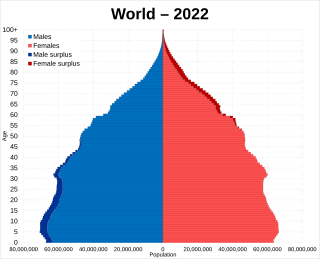Related Research Articles

Christianity is an Abrahamic monotheistic religion based on the life and teachings of Jesus of Nazareth. It is the world's largest and most widespread religion with roughly 2.4 billion followers representing one-third of the global population. Its adherents, known as Christians, are estimated to make up a majority of the population in 157 countries and territories. Christians believe that Jesus is the Son of God, whose coming as the Messiah was prophesied in the Hebrew Bible and chronicled in the New Testament.

China is the second most populous country in Asia as well as the second most populous country in the world, with a population of 1,425,671,352.

As of June 2021, the population of Singapore stands at 5.45 million. Of these 5.45 million people, 4 million are residents, consisting of 3.5 million citizens and 500,000 permanent residents (PRs). The remaining 1.45 million people living in Singapore are classed as non-residents, a group consisting mainly of foreign students and individuals on work passes.

Vodun is a religion practiced by the Aja, Ewe, and Fon peoples of Benin, Togo, Ghana, and Nigeria.

Mystery religions, mystery cults, sacred mysteries or simply mysteries, were religious schools of the Greco-Roman world for which participation was reserved to initiates (mystai). The main characterization of this religion is the secrecy associated with the particulars of the initiation and the ritual practice, which may not be revealed to outsiders. The most famous mysteries of Greco-Roman antiquity were the Eleusinian Mysteries, which predated the Greek Dark Ages. The mystery schools flourished in Late Antiquity; Julian the Apostate in the mid 4th century is known to have been initiated into three distinct mystery schools—most notably the mithraists. Due to the secret nature of the school, and because the mystery religions of Late Antiquity were persecuted by the Christian Roman Empire from the 4th century, the details of these religious practices are derived from descriptions, imagery and cross-cultural studies. Much information on the Mysteries comes from Marcus Terentius Varro.

Anthropology of religion is the study of religion in relation to other social institutions, and the comparison of religious beliefs and practices across cultures.

Slavic mythology or Slavic paganism is the religious beliefs, myths, and ritual practices of the Slavs before Christianisation, which occurred at various stages between the 8th and the 13th century. The South Slavs, who likely settled in the Balkan Peninsula during the 6th–7th centuries AD, bordering with the Byzantine Empire to the south, came under the sphere of influence of Eastern Christianity, beginning with the creation of writing systems for Slavic languages in 855 by the brothers Saints Cyril and Methodius and the adoption of Christianity in Bulgaria in 864 and 863 in Great Moravia. The East Slavs followed with the official adoption in 988 by Vladimir the Great of Kievan Rus'.
Irreligion is the neglect or active rejection of religion and, depending on the definition, a simple absence of religion.

West Asia, also called Western Asia or Southwest Asia, is the westernmost region of Asia, as defined by most academics, UN bodies and other institutions, and includes Anatolia, the Arabian Peninsula, Iran, Mesopotamia, the Armenian Highlands, the Levant, the island of Cyprus, the Sinai Peninsula, and the southern part of the Caucasus Region (Transcaucasia). The region is separated from Africa by the Isthmus of Suez in Egypt, and separated from Europe by the waterways of the Turkish Straits and the watershed of the Greater Caucasus. Central Asia lies to its northeast, while South Asia lies to its east. Twelve seas surround the region (clockwise): the Aegean Sea, the Sea of Marmara, the Black Sea, the Caspian Sea, the Persian Gulf, the Gulf of Oman, the Arabian Sea, the Gulf of Aden, the Red Sea, the Gulf of Aqaba, the Gulf of Suez, and the Mediterranean Sea. The area contains the vast majority of the similarly defined Middle East, but excluding most of Egypt and the northwestern part of Turkey, and including the southern part of the Caucasus.

The Mandara Mountains are a volcanic range extending about 190 km along the northern part of the Cameroon–Nigeria border, from the Benue River in the south to the north-west of Maroua in the north. The highest elevation is the summit of Mount Oupay, at 1,494 m (4,900 ft) above sea level.
Waaq is the name for the sky God in the Cushitic languages of both the Oromo people and Somali people in the Horn of Africa. The word still means God in present Oromo language. Some traditions indicate Waaq is associated with the Harar region.

Green week, or the green holidays, is a traditional Slavic seasonal festival celebrated in early June. It is closely linked with the cult of the dead and the spring agricultural rites. In Eastern European villages, the seven weeks following Easter have historically been a time of festivity. Green week takes place during the seventh week leading up to the Pentecost, and includes the seventh Thursday after Easter, called Semik.
Growth of religion involves the spread of individual religions and the increase in the numbers of religious adherents around the world. In sociology, desecularization is the proliferation or growth of religion, most commonly after a period of previous secularization. Statistics commonly measure the absolute number of adherents, the percentage of the absolute growth per-year, and the growth of converts in the world.

According to the official data, the Muslim population of Suriname represents about 13.9 percent of the country's total population as of 2012, which is the highest percentage of Muslims in the Americas. Though the majority belong to the Sunni sect of Islam, there are some Shi'a, and a small population of Ahmadiyyas.

Christianity is the largest religion in Botswana. However, the country is officially secular and allows freedom of religious practice.
Christianity is the predominant religion in Liberia, with Protestantism being its largest denomination. Liberia is a secular state and its constitution guarantees freedom of religion.
Demographic economics or population economics is the application of economic analysis to demography, the study of human populations, including size, growth, density, distribution, and vital statistics.
Christian population growth is the population growth of the global Christian community. According to a 2011 Pew Research Center survey, there were more than 2.2 billion Christians around the world in 2010, more than three times as many as the 600 million recorded in 1910. However, this rate of growth is slower than the overall population growth over the same time period. In 2020, Pew estimated the number of Christians worldwide to be around 2.38 billion. According to various scholars and sources, high birth rates and conversions in the Global South were cited as the reasons for the Christian population growth. In 2023, it was reported: "There will be over 2.6 billion Christians worldwide by the middle of 2023 and around 3.3 billion by 2050, according to a report published in early January by the Center for the Study of Global Christianity at Gordon Conwell Theological Seminary."

Earth has a human population of over 8 billion as of 2023, with an overall population density of 50 people per km2. Nearly 60% of the world's population lives in Asia, with almost 2.8 billion in the countries of China and India combined. The percentage shares of China, India and rest of South Asia of the world population have remained at similar levels for the last few thousand years of recorded history. The world's literacy rate has increased dramatically in the last 40 years, from 66.7% in 1979 to 86.3% today. Lower literacy levels are mostly attributable to poverty. Lower literacy rates are found mostly in South Asia and Sub-Saharan Africa.

The Sacred Mushroom and the Cross: A Study of the Nature and Origins of Christianity Within the Fertility Cults of the Ancient Near East is a 1970 book about the linguistics of early Christianity and fertility cults in the Ancient Near East. It was written by John Marco Allegro (1923–1988).
References
- ↑ Lindsay Falvey (2005), Religion and Agriculture: Sustainability in Christianity and Buddhism (PDF), Institute for International Development, pp. 13–14, archived from the original (PDF) on 2008-07-06